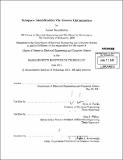| dc.contributor.advisor | Pablo A. Parrilo and Alan S. Willsky. | en_US |
| dc.contributor.author | Saunderson, James (James Francis) | en_US |
| dc.contributor.other | Massachusetts Institute of Technology. Dept. of Electrical Engineering and Computer Science. | en_US |
| dc.date.accessioned | 2011-10-17T21:30:46Z | |
| dc.date.available | 2011-10-17T21:30:46Z | |
| dc.date.copyright | 2011 | en_US |
| dc.date.issued | 2011 | en_US |
| dc.identifier.uri | http://hdl.handle.net/1721.1/66475 | |
| dc.description | Thesis (S.M.)--Massachusetts Institute of Technology, Dept. of Electrical Engineering and Computer Science, 2011. | en_US |
| dc.description | Cataloged from PDF version of thesis. | en_US |
| dc.description | Includes bibliographical references (p. 88-92). | en_US |
| dc.description.abstract | In this thesis we consider convex optimization-based approaches to the classical problem of identifying a subspace from noisy measurements of a random process taking values in the subspace. We focus on the case where the measurement noise is component-wise independent, known as the factor analysis model in statistics. We develop a new analysis of an existing convex optimization-based heuristic for this problem. Our analysis indicates that in high-dimensional settings, where both the ambient dimension and the dimension of the subspace to be identified are large, the convex heuristic, minimum trace factor analysis, is often very successful. We provide simple deterministic conditions on the underlying 'true' subspace under which the convex heuristic provably identifies the correct subspace. We also consider the performance of minimum trace factor analysis on 'typical' subspace identification problems, that is problems where the underlying subspace is chosen randomly from subspaces of a particular dimension. In this setting we establish conditions on the ambient dimension and the dimension of the underlying subspace under which the convex heuristic identifies the subspace correctly with high probability. We then consider a refinement of the subspace identification problem where we aim to identify a class of structured subspaces arising from Gaussian latent tree models. More precisely, given the covariance at the finest scale of a Gaussian latent tree model, and the tree that indexes the model, we aim to learn the parameters of the model, including the state dimensions of each of the latent variables. We do so by extending the convex heuristic, and our analysis, from the factor analysis setting to the setting of Gaussian latent tree models. We again provide deterministic conditions on the underlying latent tree model that ensure our convex optimization-based heuristic successfully identifies the parameters and state dimensions of the model. | en_US |
| dc.description.statementofresponsibility | by James Saunderson. | en_US |
| dc.format.extent | 92 p. | en_US |
| dc.language.iso | eng | en_US |
| dc.publisher | Massachusetts Institute of Technology | en_US |
| dc.rights | M.I.T. theses are protected by
copyright. They may be viewed from this source for any purpose, but
reproduction or distribution in any format is prohibited without written
permission. See provided URL for inquiries about permission. | en_US |
| dc.rights.uri | http://dspace.mit.edu/handle/1721.1/7582 | en_US |
| dc.subject | Electrical Engineering and Computer Science. | en_US |
| dc.title | Subspace identification via convex optimization | en_US |
| dc.type | Thesis | en_US |
| dc.description.degree | S.M. | en_US |
| dc.contributor.department | Massachusetts Institute of Technology. Department of Electrical Engineering and Computer Science | |
| dc.identifier.oclc | 756457110 | en_US |
